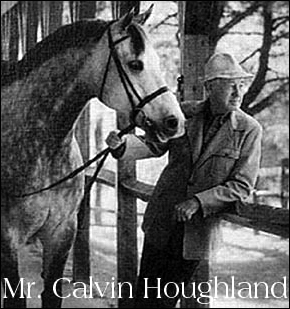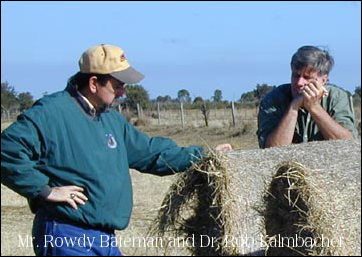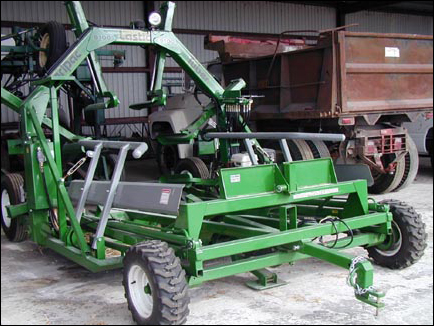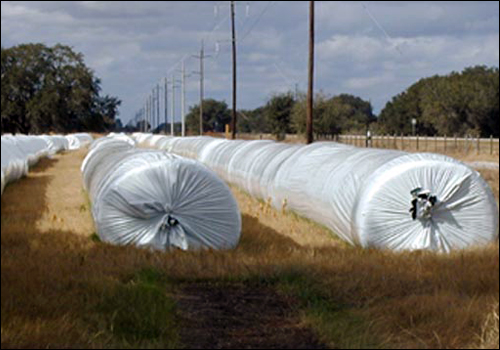- Return to main Featured Ranch Archives index
Bright Hour Ranch
February 2001
From their aerial photography of southwest Florida in 1994, the Nature Conservancy staff saw a 72-square mile mosaic of plant community – gradations of black and white that indicated dry prairies, hammocks, scrub and scores of marshes, unmarred by roads or development. They were looking at Bright Hour Ranch located on State Road 70 just east of Arcadia. Mr. Calvin Hougland, the 83 year-old businessman from Tennessee and owner, had bought the ranch in 1964 as a place on which to raise cattle, relax, hunt and be outdoors with family, friends and nature. He had renamed this sanctuary, "Bright Hour" after a "good luck" steeplechase horse he owned as a teenager in Tennessee.

In January this year, Dr. Rob Kalmbacher and I were privileged to visit with Ranch Manager and life-long resident of Bright Hour, Mr. Rowdy Bateman, and learn more about their operation.

Currently, Bright Hour Ranch is a 46,000 acre commercial cow-calf operation with approximately 18,000 acres in improved pasture and sod service integrated with a 1000-acre citrus and watermelon farm, and the balance of approximately 28,000 acres in a nature conservancy plan that perpetually supports native grazing by cattle and wildlife.
In 1970, Mr Hougland bought some Beefmaster bulls to breed to the existing Brahman cross cow herd. He was so pleased with the Beefmasters that today the 8,500 head cow-calf herd consists mainly of Beefmaster and Angus crosses. Mr. Bateman finds the high fertility, moderate cow-size and good marketability of the Angus breed, and the Brahman "tolerance" blood and closed sheath characteristics in the Beefmaster crosses as a winning combination. The bulls are put on the cows on December 1 at a ratio of 1 bull to 20 cows. The ranch retains ownership of approximately 500 heifer calves yearly.
Improved pastures are mainly of Pensacola and Argentine bahiagrasses in 640-acre sections. There are a few acres of bermudagrass pasture and 50 acres of Rhodesgrass hay field. At variance to most south Florida ranches, Bright Hour ranch adopts a fall pasture fertilization program when about 400 pounds of 20-10-10 fertilizer are applied in September. Probably the uniquely low-lying topography of the ranch allows for adequate residual soil moisture and fertilizer nutrient uptake after the usually wet summer months. A special aspect of the Ranch's forage program is their haylage-tubing operation.
State-of-the-art machinery on site is capable of baling and wrapping haylage at the rate of 250-370 round bales per day with 37 bales in a row of tubes. All the Rhodesgrass forage and some bahiagrass and bermudagrass pasture are cut for haylage. Cut grass is wilted to 50-55% moisture before treating with a liquid mold inhibitor (organic acids), baling and wrapping all in one operation. The liquid inoculant helps preserve the forage and also improves intake of haylage at feeding. Many travelers on SR 70 stop over to admire the haylage tubing operation when in process.


Bright Hour Ranch is a pioneer in environmental conservancy and a whole book can easily be devoted to this subject. Mr. Bateman says "We look at wildlife conservation not as one of the things you have to do but as one of the things you must morally do. It has always been and remains an integral part of this ranch". By providing leadership that promotes deep conservation ethics in all his staff, Mr. Hougland has maintained an incredibly intact landscape for wildlife, water, cattle and natural habitats. Nearly every species of animal that is native to Florida calls Bright Hour Ranch home. White tail deer, turkey, quail and wild hogs are the main sporting games, but sandhill cranes and ducks are seen in abundance. Cara Cara and burrowing owls, and rare animals such as the Florida grasshopper sparrow, Florida scrub-jay, Eastern indigo snake and even an occasional Florida panther are encountered. The Conservancy ecologist in Florida, Mr. Richard Hilsenbeck, notes that two of the ranch's 12 natural communities are globally imperiled and 17 rare vertebrate species are Federally listed as threatened or endangered.
The ranch employs many methods to enhance the natural habitat. By clearing a one-mile wide border of pasture around three sides for the ranch's traditional revenue products – cattle, oranges, hay and sod – Mr. Hougland and his staff kept the ranch's interior wild. Even fences were kept to a minimum. When we got to this area, Mr. Hougland reportedly said "I can't stand to see a fence right across that pretty slough so we stopped it right there and picked it up on the other side". Burning of native grassland is controlled on a 3-year rotation to rejuvenate grass and keep underbrush in check. With a controlled hunting policy, only a few people get to hunt at Bright Hour Ranch, and those who do have strict self-imposed limits of quail, comply with state limits on deer, ducks, turkeys, and participate in state-sanctioned alligator harvesting. In restricted, no-hunting, mowed game trails, feed are put out for deer, turkey and birds like the threatened sandhill crane. They also plant plots of prescribed feed, wild oats and native peas. Recognizing the importance of water systems, the ranch constructed a weir that provides a 20-acre plus fresh water lake, controlling runoff from a canal that serves as the major water source not only for livestock and wildlife but also a major source of drinking water for the city of Punta Gorda.
In 1995, Bright Hour Ranch received the Commissioner's Ag. Environmental Leadership Award for wildlife in Florida. In 1998, Mr. Hougland concluded a conservancy easement agreement with the Southwest Florida Water Management District on the 28,400 acre natural habitat which allows cattle grazing in private ownership but prohibits future development and legally protects the natural character of the land in perpetuity. There is also the human touch to Bright Hour Ranch. Nearly everybody on the ranch is kin to each other. Today, Mr. Zeke Browning, born 77 years ago and former ranch foreman who showed Mr. Hougland around while he considered buying the ranch, manages the ranch's water and wildlife. Chobee Bateman, is the ranch's secretary for 37 years and her son, Rowdy Bateman whom we visited, is the ranch manager, having foregone a successful career in banking to rejoin the working family. Robert Browning, Zeke's nephew, manages the cattle operation. The staff speaks of Hougland with a mixture of respect and affection. Some of their children are attending college through a scholarship fund that Mr. Hougland set up specifically for them with profits from the hog operations and fees paid by professional alligator trappers. Mr. Bateman and Mr. Hougland, we of RCREC Newsletter salute you for letting us briefly into your and our wonderful world of Bright Hour.

